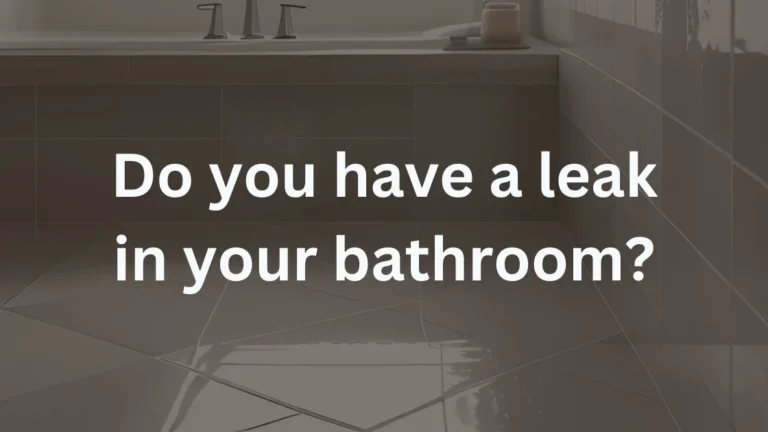A major water leak from your bath or shower can lead to costly repairs and significant water damage if not addressed promptly. Recognising the early warning signs of a leak is essential to prevent extensive damage to your home.
In this article, we’ll explore the key indicators of a major water leak originating from your bath or shower. By understanding these signs, you can take swift action to diagnose and fix the problem, safeguarding your property and peace of mind.
- Key indicators of a major water leak from your bath or shower include puddles and damp patches, which signal immediate concerns.
- Look for water stains or discolouration on walls and ceilings; these often reveal underlying issues.
- Peeling paint or wallpaper may indicate moisture problems, while soft or spongy floors suggest structural damage.
- Unusual sounds, such as dripping or hissing, can signify pipe leaks, while unexpected spikes in your water bill may point to hidden leaks.
- Recognising these signs early can save you costly repairs.
Puddles and Damp Patches
Puddles and damp patches are often the initial indicators of a potential water leak, warranting immediate attention.
These unexpected wet spots, particularly around showers, baths, or cabinets, should not be overlooked, as they can signify underlying plumbing or structural issues. Check out these other signs for a leak around your bathroom sink.
Effective leak detection requires vigilance; even seemingly minor damp areas can evolve into significant problems if left unaddressed.
Regular moisture monitoring in areas prone to humidity is essential for early identification of leaks, helping to prevent extensive damage and costly repairs.
By fostering a proactive approach to inspecting these critical spaces, homeowners can cultivate a safer environment and mitigate the risks associated with unresolved leaks.
In the end, staying attuned to these subtle signs fosters a sense of belonging in a well-maintained home.
Mould Growth and Odours
Unattended damp areas can create an environment conducive to mould growth, which poses significant health risks and further complicates the issue of water leaks.
Bathrooms are particularly vulnerable, as mould thrives in humid conditions exacerbated by persistent leaks. The presence of mould often signifies underlying moisture problems, and unusual growth in areas distant from water sources may indicate hidden leaks that demand urgent attention.
Musty odours are another common sign of mould, stemming from moisture accumulation; effective odour detection is essential for timely mould remediation.
Peeling Wallpaper and Paint
Peeling wallpaper and paint often serve as visible clues to underlying moisture issues, typically stemming from plumbing leaks or inadequate ventilation.
Identifying the causes of this deterioration is essential for effective preventive maintenance, as it can help homeowners mitigate potential damage before it escalates.
Regular inspections and prompt repairs not only preserve the aesthetics of the space but also protect the integrity of the home’s structure.
Causes of Peeling Wallpaper
While various factors can contribute to the deterioration of wallpaper, one of the most common causes is the presence of dampness that infiltrates walls. This moisture often arises from plumbing or roofing leaks, leading to water damage that weakens the adhesive, resulting in peeling.
In bathrooms, inadequate ventilation can intensify humidity levels, fostering mould growth that further compromises wallpaper integrity. Additionally, poor wall preparation before installation can hinder the ability to seal out moisture effectively, leading to adhesive failure.
Regular inspections for leaks and maintaining ideal humidity levels are essential for preserving wallpaper and ensuring a welcoming atmosphere in your home. Understanding these causes fosters a sense of community knowledge, helping everyone maintain their living spaces better.
Preventive Maintenance Tips
Effective preventive maintenance is essential for preserving the aesthetics and integrity of wallpaper and paint, particularly in moisture-prone areas like bathrooms.
Conducting regular preventive inspections can help identify issues before they escalate. Here are some tips for ensuring your bathroom remains in excellent condition:
- Inspect Regularly: Check for signs of peeling to catch dampness early.
- Choose Quality Materials: Use moisture-resistant paint and wallpaper designed for bathrooms.
- Ensure Proper Ventilation: Install extractor fans to minimise humidity levels and prevent deterioration.
- Repair Leaks Promptly: Address any leaks around sinks, baths, and showers to avoid moisture buildup.
Tiling and Grout Issues
Tiling and grout issues are often clear indicators of potential water leaks within a structure.
PCLA are regularly called to properties and asked to represent homeowners wishing to make a claim for water damage, only to find that the damage has resulted from failed sealant around a shower tray or grout between tiles. Insurers typically do not cover these claims as they attribute them to maintenance issues i.e. if the areas had been maintained then the damage wouldn’t have occured.
Loose or broken tiles can create vulnerabilities, while damaged grout seals allow for water intrusion that may lead to extensive damage. Regular inspection and maintenance of these surfaces are essential to identify and address problems before they escalate so you are not left with a costly repair bill that the Insurance company may be unlikely to cover.
Loose or Broken Tiles
Loose or broken tiles in a bathroom are more than just an aesthetic concern; they can signal serious underlying issues that may lead to water leaks. Ignoring these signs can result in costly repairs and extensive damage.
To protect your property, watch for the following indicators:
- Spongy Tiles: If tiles feel soft or unstable, moisture may be trapped underneath.
- Discolouration: Stains or colour changes can indicate water infiltration.
- Cracks: Small cracks in tiles can grow, allowing more water entry.
- Missing Grout: Damaged grout compromises the water tightness of the area, increasing the chances that water can leak through.
Timely tile replacement and professional assessment can prevent water intrusion and safeguard your bathroom’s structural integrity. It is essential, when any of these issues become apparent, that they are repaired as soon as possible to prevent costly repairs down the line.
Damaged Grout
Over time, grout can wear down, allowing water to seep through the tiles and potentially causing extensive damage if left unaddressed.
Regular grout maintenance is essential to preserving the integrity of your bathroom. Inspect grout joints for cracks or gaps, as these may indicate underlying leaks or moisture issues.
Promptly replacing worn or deteriorated grout can prevent further water damage and mould growth. Rake out damaged or loose grout from between the tiles and replace it. Employ effective sealing techniques to enhance grout durability, ensuring it withstands repeated moisture exposure.
For extensive grout damage, a professional evaluation may be necessary, as neglecting these issues can lead to costly repairs in the future.
Water Intrusion Risks
A significant risk of water intrusion arises from compromised tiling and grout conditions in bathrooms. Broken or loose tiles and deteriorating grout can create pathways for water, leading to hidden leaks and structural damage.
Regular inspections are essential for effective leak detection and to mitigate potential issues caused by fluctuations in water pressure.
Consider these key indicators of water intrusion risks:
- Cracked or loose tiles that allow moisture seepage.
- Deteriorated grout that fails to create a watertight seal.
- Visible mould growth in damp areas, indicating prolonged moisture exposure.
- Water stains on walls or ceilings, suggesting hidden leaks.
Addressing these concerns promptly can prevent costly repairs and maintain a safe, healthy living environment.
Unusual Noises and Sounds
Listening carefully for unusual noises and sounds can be a crucial step in detecting water leaks within your home.
Dripping sounds are often the initial indicator of trouble; they may suggest a leaking tap or showerhead that requires urgent attention to avoid further damage. These persistent sounds are not only irritating but can lead to significant water loss and costly repairs if ignored.
Moreover, hissing noises may signal air escaping from damaged pipes, highlighting potential leaks in your plumbing system.
Recognising the signs of a potential water leak in your system, especially when fixtures are turned off, can uncover hidden leaks that might otherwise go unnoticed.
Water Stains and Discoloration
Among the most telling signs of a water leak are water stains and discolouration, which can manifest on ceilings and walls throughout your home.
These stains often indicate a leak from your bath or shower areas, necessitating prompt attention. Typically appearing as yellow or brown patches, stain patterns may expand over time, signalling the urgency of early detection.
Consider these indicators:
- Darkened areas around fixtures, such as taps or showerheads.
- Bubbling paint or peeling wallpaper nearby.
- Gradual discolouration that suggests a slow leak.
- Consistent monitoring of stains to track changes over time.
Addressing these issues early can help prevent extensive structural damage and maintain your home’s integrity.
High Water Bills
Unexpected spikes in water bills can serve as a critical indicator of a hidden leak within your home, particularly in areas such as bathrooms and showers.
If your recent bill shows a substantial increase without a corresponding rise in water usage, it may signal a leak warranting immediate attention. Regular monitoring of your water consumption is essential for effective leak detection and promotes water conservation.
The average household uses around 135 litres daily, but even a minor leak can waste over 45,000 litres annually, greatly impacting your expenses.
Many utility companies offer usage tracking tools, enabling you to identify discrepancies early on. By staying vigilant, you not only protect your wallet but also contribute to sustainable water practices within your community.
Soft or Spongy Floors
One of the most telling signs of a water leak in your home is the presence of soft or spongy floors, particularly in areas like bathrooms.
This condition often indicates that water has compromised the structural integrity of the subflooring, leading to potential hazards.
To address this issue effectively, consider the following:
- Regular Subfloor Inspection: Conduct routine checks to assess floor stability.
- Moisture Detection: Employ moisture meters to identify hidden leaks.
- Prompt Repairs: Act swiftly to mitigate further damage when sponginess is detected.
- Professional Assessment: Engage experts for a thorough evaluation if issues persist.
Ignoring soft floors can escalate into extensive structural damage and increased repair costs.
Stay vigilant to protect your home and ensure safety for all its occupants.
Key Takeaways
- Look for puddles or damp patches around the bath or shower, indicating potential leaks that require immediate attention.
- Check for water stains or discolouration on walls and ceilings, which can signal hidden leaks behind surfaces.
- Notice any peeling wallpaper or bubbling paint, as these often suggest moisture issues related to plumbing leaks.
- Listen for unusual noises, such as dripping or hissing sounds, which may indicate leaking fixtures or damaged pipes.
- Monitor your water bills for unexpected spikes, as they can reveal hidden leaks wasting significant amounts of water.
Suspect a leak in your bathroom?
Our Bathroom Leak Detection Company in Northern Ireland is here to save your home from hidden water damage!
Imagine the unseen damage a bathroom leak could cause—soaring bills, mould growth, and compromised structural integrity. Our expert team uses state-of-the-art technology to detect leaks quickly and accurately, ensuring your bathroom and home stay safe and dry.
Picture the relief you’ll feel knowing every potential leak in your bathroom has been identified and addressed. Our non-invasive, efficient detection methods mean minimal disruption to your household while providing maximum accuracy and protection. Trust Northern Ireland’s leading leak detection specialists to safeguard your bathroom and home.
Don’t let hidden leaks cause costly damage—act now! Contact Northern Ireland’s most trusted Bathroom Leak Detection Company today.



